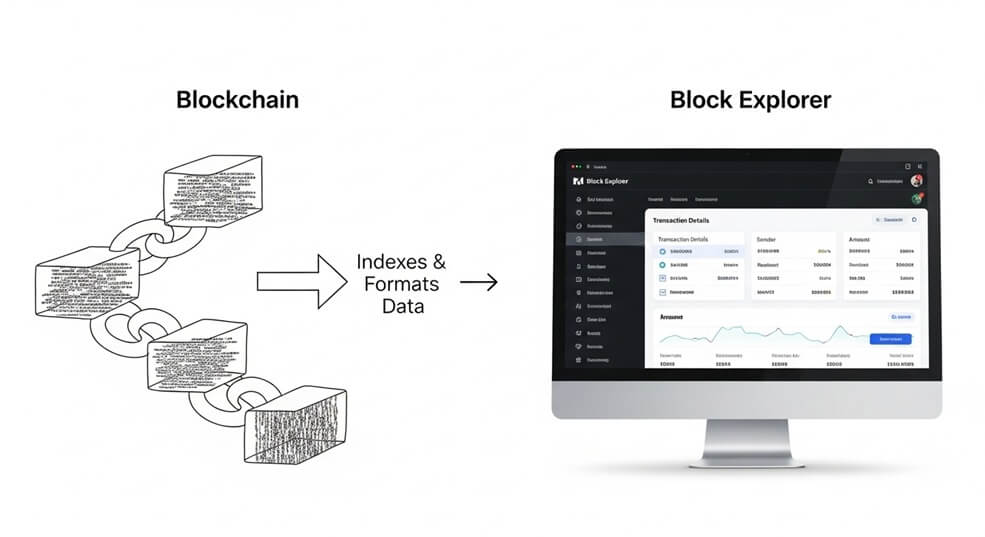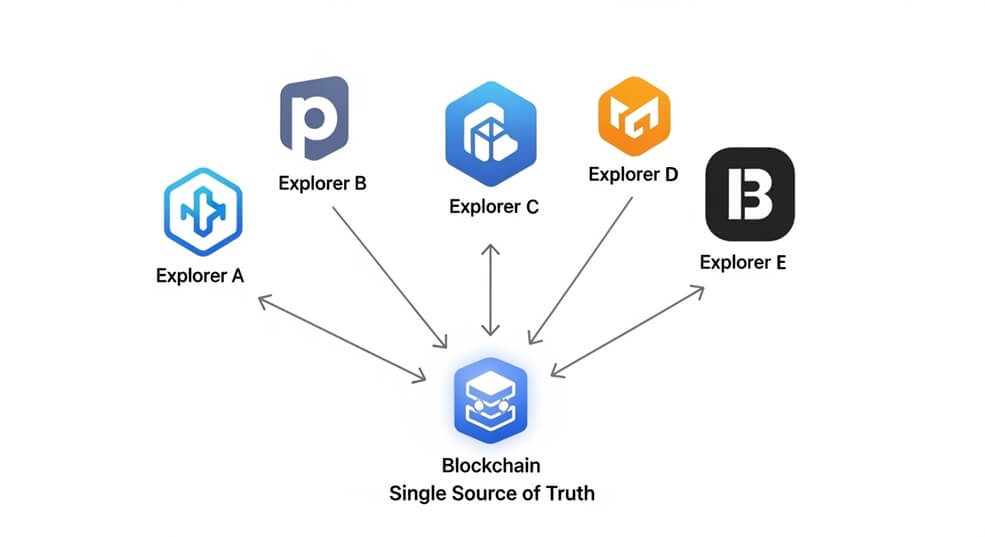Key Takeaways
- Blockchain search engine: A block explorer is a web tool that lets anyone view and verify data on a public blockchain. It’s like a search engine or browser for the blockchain, indexing every block, transaction, and address for easy lookup.
- Search by TX, address, or block: Enter a transaction ID (hash), wallet address, or block number to view details such as sender/recipient, amount, fee, timestamp, and confirmation status.
- Chain-specific tools: Each blockchain has its own explorers (e.g., Etherscan for Ethereum, Blockchain.com for Bitcoin). You cannot query Bitcoin data on an Ethereum explorer or vice versa.
- Verify and analyze transactions: Explorers help confirm whether a transaction is pending or finalized, and provide network data such as gas fees, latest blocks, and mempool size.
- Public data & privacy: Explorer results are fully public and pseudonymous. Never enter private keys, and always verify you are on a trusted site to avoid phishing.
What Is a Block Explorer?
A block explorer (or blockchain explorer) is an online application that allows anyone to browse and search the records stored on a blockchain. It pulls data directly from the public ledger and presents it in a human-readable format. Every block, transaction, and wallet address ever recorded is indexed and can be queried.
Analogy: Think of the blockchain as a massive public library of all transactions. A block explorer is the library’s search catalog: you can look up any “book” by its index (a block or transaction ID) or any “author” by name (an address) and instantly read its contents.

Basic Navigation – Transactions, Addresses, Blocks
Transactions
Paste a transaction hash into the search bar to see its “receipt” on the blockchain: sender, recipient, amount, timestamp, fee, and current confirmation count. This is the fastest way to confirm that your transfer was included in a block.
Addresses (Wallets)
Entering a wallet address shows its current balance and complete transaction history. Many explorers also list any tokens (ERC-20, NFTs, etc.) held by that address. Keep in mind that anyone can view this information – blockchain transparency is a two-edged sword.
Blocks
Searching a block number (height) or block hash displays that block’s miner/validator, timestamp, size, and the list of all transactions it contains. Browsing recent blocks is a good way to see network activity in real time.

Advanced Uses and Tips
- Track confirmations: When waiting for a crypto deposit on an exchange, watch the confirmation counter to know when your funds are fully credited.
- Monitor network congestion: Many explorers display pending transactions or current gas fees so you can decide whether to wait or pay a higher fee.
- Inspect smart contracts: On Ethereum explorers, you can read verified contract code and even interact with “read/write” functions (advanced users only).
- Follow wallet activity: Analysts track “whale” wallets to see large transfers. You can also export CSV data for taxes or research.
- Use multiple explorers: If one site is slow or offline, try an alternative (e.g., Blockchair for Bitcoin, Ethplorer for Ethereum) to cross-check results.

Risks & Important Considerations
- Verify the URL: Phishing sites imitate popular explorers. Check the domain (e.g., etherscan.io, blockchain.com) and ensure the connection is secured (HTTPS).
- Read-only by default: Explorers should never ask for your private keys or seed phrase. If a site requests them, leave immediately.
- Confirmation depth: Treat transactions as final only after enough confirmations (e.g., six for Bitcoin) to protect against rare chain reorganizations.
- Privacy trade-offs: Querying your own address on a public explorer can link your IP to that address in the explorer’s logs. For higher privacy, consider privacy-focused explorers or run your own node.
- No fees required: Legitimate explorers are free for basic lookups. If a site charges you just to see a transaction, it’s likely a scam.
The following links are provided for educational and informational purposes only. Literacy & Innovation in Financial Technology Alliance (LIFT) does not endorse any of the organizations, products, services, or opinions presented on these external sites. LIFT is not responsible for the accuracy or content of external sites. We encourage you to conduct your own research.
Further Reading & Sources
Disclaimer: This article is for educational purposes only and does not constitute financial advice.